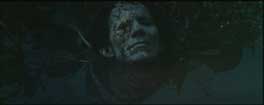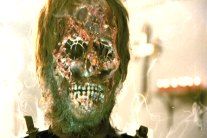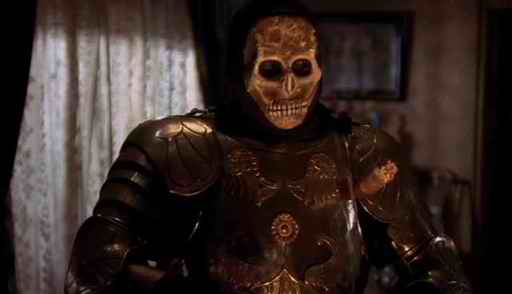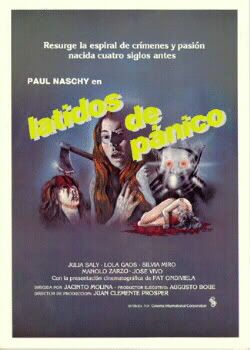Swamp of the Ravens
by Manuel Caño
 Young Dr. Costa is desperately seeking funds for his experiments. Because they require the use of corpses, he, like doctors Cameron, Craigis, and Vornoff before him, has been laughed out of the field of legitimate science and forced to live the life of a recluse in the middle of a swamp. Well, almost. Because he can't get the supply of corpses he needs through the proper channels, he skirts them altogether. This means going out every few days like an urban Dr. Frankenstein to either pick up a girl or convince a homeless guy to come back to his shack in the middle of the titular swamp (there are a load of ravens, in case you were wondering, but damned if I know what they're doing there). As his subjects have a very low return rate, the authorities get involved in that ineffectual way they do. A police inspector comes close to figuring things out a few times, but in the end, things just implode in on our crazy doctor in true Frankenstein Fashion. Costa's assistant at first seems a willing cohort, but she changes horses somewhere during the film's 83 minutes and is the only one left by the time our mad doctor gets his comeuppance, I think.
Young Dr. Costa is desperately seeking funds for his experiments. Because they require the use of corpses, he, like doctors Cameron, Craigis, and Vornoff before him, has been laughed out of the field of legitimate science and forced to live the life of a recluse in the middle of a swamp. Well, almost. Because he can't get the supply of corpses he needs through the proper channels, he skirts them altogether. This means going out every few days like an urban Dr. Frankenstein to either pick up a girl or convince a homeless guy to come back to his shack in the middle of the titular swamp (there are a load of ravens, in case you were wondering, but damned if I know what they're doing there). As his subjects have a very low return rate, the authorities get involved in that ineffectual way they do. A police inspector comes close to figuring things out a few times, but in the end, things just implode in on our crazy doctor in true Frankenstein Fashion. Costa's assistant at first seems a willing cohort, but she changes horses somewhere during the film's 83 minutes and is the only one left by the time our mad doctor gets his comeuppance, I think.About now, you're probably wondering what this film is doing here on a sight about zombies, other than to fit into that confusing anecdote I told at the beginning of my Messiah of Evil review. Well, everytime Costa is finished with his experiments, he flushes the corpses out into the bog that surrounds his house. This means about halfway through the film we start seeing the heads of those he's killed surface out of the swamp water and stare ominously at the camera (it's actually pretty effective and spooky). Toward the end, one of them gets up and walks around because a lot of the contaminants Costa's been favoring have made their way into the swamp water which I suppose has the unintended effect of making zombies. I can't really be certain. I can't really be certain of anything. The film, shot in Ecuador, of all places, makes so many detours and languishes over the dialogue in the scenes surrounding the action that you'd think it really meant something, but it doesn't. And because we don't even really know what in Christ Costa's experiments are supposed to prove, even the scenes of the experimentation lose whatever gravity they may have carried in the planning stages.
 And if that weren't enough to make the movie a mess, in true psychotronic fashion, director Manuel Caño diverges every couple of scenes to take us to a night club where Costa's girlfriend hangs out. We're treated, in much the same way we're treated to open mic night in The Incredibly Strange Creatures Who Stopped Living And Became Mixed-Up Zombies, to the club's biggest draw, a guy who sings to a dummy. I'd like to think they were doing what Ray Dennis Steckler did in his film, just padding the film to make time between the scenes that pertain to the admittedly muddled, if undeniably linear plot. I abandoned this hypothesis when I realized that there is no real plot. There's more scenes of Costa wining and dining strange women and of the detective piecing together his crimes (to no end) than there is of what might be called the story. In other words, the film just kinda hangs out with its characters. We're given scenes of Costa having sex with his dead girlfriend, unprecedented psychedelic freak outs and real autopsy footage out of the blue and as neither fits into the story arch and both take as much time as said arch, the film is about as confusing a trip you're likely to have in front of a screen. I spent most of the film with eyebrows arched wondering what was I seeing. It's like someone made a film about Dr. Costa and his experiments, but lost half of it and gave it to his cousin to finish on the cheap who was really into drugs and rock music and who ran into some stock footage he found totally awesome. The problem is Caño was his own stupid cousin in this instance and his film is really a mess. Swamp of the Ravens is, if nothing else, a gathering point for some of crap cinema's weirdest performers. Look for turns by Bill Harrison from Deep Throat and Fernando Sancho from Return of the Blind Dead and Ramiro Oliveros from Cannibal Apocalypse. Their characters aren't given names, which I believe tells you something about the script and the film as a whole. With editing, this could have been a real movie, which makes me wonder about a lot of things. How did Manuel Caño even get creeps like Bill Harrison to come to Ecuador to make this film? What was this film supposed to look like? Should I bother asking or should I just write this off to "how things were in 1974"?
And if that weren't enough to make the movie a mess, in true psychotronic fashion, director Manuel Caño diverges every couple of scenes to take us to a night club where Costa's girlfriend hangs out. We're treated, in much the same way we're treated to open mic night in The Incredibly Strange Creatures Who Stopped Living And Became Mixed-Up Zombies, to the club's biggest draw, a guy who sings to a dummy. I'd like to think they were doing what Ray Dennis Steckler did in his film, just padding the film to make time between the scenes that pertain to the admittedly muddled, if undeniably linear plot. I abandoned this hypothesis when I realized that there is no real plot. There's more scenes of Costa wining and dining strange women and of the detective piecing together his crimes (to no end) than there is of what might be called the story. In other words, the film just kinda hangs out with its characters. We're given scenes of Costa having sex with his dead girlfriend, unprecedented psychedelic freak outs and real autopsy footage out of the blue and as neither fits into the story arch and both take as much time as said arch, the film is about as confusing a trip you're likely to have in front of a screen. I spent most of the film with eyebrows arched wondering what was I seeing. It's like someone made a film about Dr. Costa and his experiments, but lost half of it and gave it to his cousin to finish on the cheap who was really into drugs and rock music and who ran into some stock footage he found totally awesome. The problem is Caño was his own stupid cousin in this instance and his film is really a mess. Swamp of the Ravens is, if nothing else, a gathering point for some of crap cinema's weirdest performers. Look for turns by Bill Harrison from Deep Throat and Fernando Sancho from Return of the Blind Dead and Ramiro Oliveros from Cannibal Apocalypse. Their characters aren't given names, which I believe tells you something about the script and the film as a whole. With editing, this could have been a real movie, which makes me wonder about a lot of things. How did Manuel Caño even get creeps like Bill Harrison to come to Ecuador to make this film? What was this film supposed to look like? Should I bother asking or should I just write this off to "how things were in 1974"? You'd never mistake Swamp of the Ravens for Dawn of the Dead, but there's a kooky, drug-addled charm to this film that makes it fun to watch in spite of the fact that on a bet you couldn't figure out what's really going on beneath it's Frankenstein-esque story. What I'd truly like to see is Santiago Moncada's script for this film but something tells me it's been torn up and rolled really tightly. Now if you're looking for a film that knows how to mess with your head while still giving you something like a cohesive story, look no further than Panic Beats.
You'd never mistake Swamp of the Ravens for Dawn of the Dead, but there's a kooky, drug-addled charm to this film that makes it fun to watch in spite of the fact that on a bet you couldn't figure out what's really going on beneath it's Frankenstein-esque story. What I'd truly like to see is Santiago Moncada's script for this film but something tells me it's been torn up and rolled really tightly. Now if you're looking for a film that knows how to mess with your head while still giving you something like a cohesive story, look no further than Panic Beats.Panic Beats
by Paul Naschy
 I've tangoed with Paul Naschy (née Jacinto Molina) before, in the context of his truly terrible Vengeance of the Zombies. Perhaps aware that that film sucked like few films know how to, he went back to the zombie genre, this time without his sometime collaborator, director Leon Klimovsky. This film, about a man whose inherited misogyny leads to devilish doings, is complex and relishes in some rather slow stolen plot points, but it's as good a film as Naschy ever made. The reason perhaps that it's bearable is because it steals from much better films than his previous efforts. This time we're given a film eerily reminiscent of the remarkable Les Diaboliques. And when you're stealing from Henri-Georges Clouzot, your film simply becomes better by association, even if it's no damned good otherwise.
I've tangoed with Paul Naschy (née Jacinto Molina) before, in the context of his truly terrible Vengeance of the Zombies. Perhaps aware that that film sucked like few films know how to, he went back to the zombie genre, this time without his sometime collaborator, director Leon Klimovsky. This film, about a man whose inherited misogyny leads to devilish doings, is complex and relishes in some rather slow stolen plot points, but it's as good a film as Naschy ever made. The reason perhaps that it's bearable is because it steals from much better films than his previous efforts. This time we're given a film eerily reminiscent of the remarkable Les Diaboliques. And when you're stealing from Henri-Georges Clouzot, your film simply becomes better by association, even if it's no damned good otherwise.The prologue, which looks alot like the one from Night of the Seagulls, shows us a night brutally murdering his wife with a flail. Seriously, that's all it is. Flash forward a hundred years into the future where a man, Paul (Jacinto himself), is experiencing some monumental stress. He's being given a collective ass-ache by the four women in his life, his wife Genevieve, his housekeeper Mabile, his old mistress Mireille, and Julie, his new girlfriend. He's taken his wife to the old family home where his mother lives in the hopes of quelling some of her stress. Genevieve has a bad heart, you see, and Paul seems to think the country air will clear her head (if every cinematic doctor in history thinks so, there must be some truth to that old chestnut). He seems like a nice enough guy until you figure out he's having an affair with Julia, his secretary or assistant, or something. I'm not sure what she does, but she hangs out all the damn time and Genevieve isn't immediately suspicious, so she must be getting paid to do something, even if its a cover for her affair with Paul. Whatever Julia's title is, she's no help to Genevieve, who starts imagining snakes and dead people are out to get her. Between his mother's constant nagging, his wife's frequent hallucinations, and his hiding an affair right under said wife's nose, he has quite a bit on his plate. So when old flame Mireille comes out of the woodworks with a scheme to filch money from Paul, he just about loses it. What would Simone Signoret do? I guess now's as good a time as any to mention that the knight from the prologue is Paul's ancestor Alaric de Marnac and there's supposed to be a curse surrounding him that goes something like this: every 100 years, Alaric shows up to revenge his male descendants against the women who make his life miserable (is that significant cause for a 100 year old curse?). I don't think anyone's going to be surprised to learn that the bodies start piling up around now.
 The panic beats of the title begin to make sense once you place the story in the context of the film it's ripping off. I think what those were a reference to is the increased heart rate we hear coming from Genevieve when she starts hallucinating. And speaking of those hallucinations, Naschy does something really kind of smart and confusing at the same time with those. When Genevieve's visions become more violent toward the end of act one, and she starts seeing both the living corpses in her bathroom and the ghost of the knight, Naschy counts on the audience assuming it's all part of the plot, per se. Specifically, because he reveals, to absolutely no one's surprise that the knight's ghost is actually Paul in disguise trying to drive her into an early grave, he wants us to believe that the zombies in the bathroom are also part of the plot. They aren't, which leads to the films one saving grace, that the ghost is in fact real and so are the zombies. The first clue comes after Paul and Julia have killed both Genevieve and Mireille and the film keeps going. It makes you think wonder if killing the other women wasn't the point of the film, what is? Naschy then turns his Diabolique rip-off into a bona-fide horror film with the third act in which our protagonist and perceptions change on us in an instant.
The panic beats of the title begin to make sense once you place the story in the context of the film it's ripping off. I think what those were a reference to is the increased heart rate we hear coming from Genevieve when she starts hallucinating. And speaking of those hallucinations, Naschy does something really kind of smart and confusing at the same time with those. When Genevieve's visions become more violent toward the end of act one, and she starts seeing both the living corpses in her bathroom and the ghost of the knight, Naschy counts on the audience assuming it's all part of the plot, per se. Specifically, because he reveals, to absolutely no one's surprise that the knight's ghost is actually Paul in disguise trying to drive her into an early grave, he wants us to believe that the zombies in the bathroom are also part of the plot. They aren't, which leads to the films one saving grace, that the ghost is in fact real and so are the zombies. The first clue comes after Paul and Julia have killed both Genevieve and Mireille and the film keeps going. It makes you think wonder if killing the other women wasn't the point of the film, what is? Naschy then turns his Diabolique rip-off into a bona-fide horror film with the third act in which our protagonist and perceptions change on us in an instant.Panic Beats feels draggy at times and could have done without a lot of its characterization, but I forgive it because of that conclusion. That this film was based around the idea of a curse which is not only misogynistic, but also petty is kind of a big misstep, but what 80s horror film wasn't petty and misogynistic. But seriously, a knight needs to come back in arbitrary installments to make sure no one's bullying his male heir? It's not like the man's the king of fucking Spain, he's just a guy who can't stay faithful to his wife, who doesn't deserve half of what she gets in the film. Thought it suffers from its really boyish plot which amounts mostly to the daydream of an unhappily married dickweed, the effects are quite gruesome (that business with the flail is especially horrific) and the film is nicely shot. Panic Beats feels like a film with setbacks, not something shot in a series of basements on the cheap strung together with B-roll and predicated upon one special effect (in other words, not Vengeance of the Zombies). This is a film with a budget, mostly capable actors, and a decent twist that springs from the ashes of a recycled plot....it's almost like Paul Naschy was really trying. Though I'd like to point something out to people who might be thinking of directing themselves in their own movie in the near future. Having already seen Vengeance, I know what Jacinto Molina looks like with his shirt off and a pair of rather sorry looking goat horns glued to his head. What I never ever in a million years needed to see was Jacinto Molina in a bathtub smoking a cigar. Not ever did I want to see that, and now I have, so directors take note. Don't film yourself nude just because you're the one calling the shots. I know the impulse is going to rear its head, but for heaven's sake don't give in.
 I had a lot more fun with Panic Beats than I thought I would and if you've seen all the usual zombie fare and want something else, give it a try. I wouldn't try Swamp of the Ravens without a room of full of friends or a fistful of hallucinogenics otherwise it might stain your conscious.
I had a lot more fun with Panic Beats than I thought I would and if you've seen all the usual zombie fare and want something else, give it a try. I wouldn't try Swamp of the Ravens without a room of full of friends or a fistful of hallucinogenics otherwise it might stain your conscious.








No comments:
Post a Comment